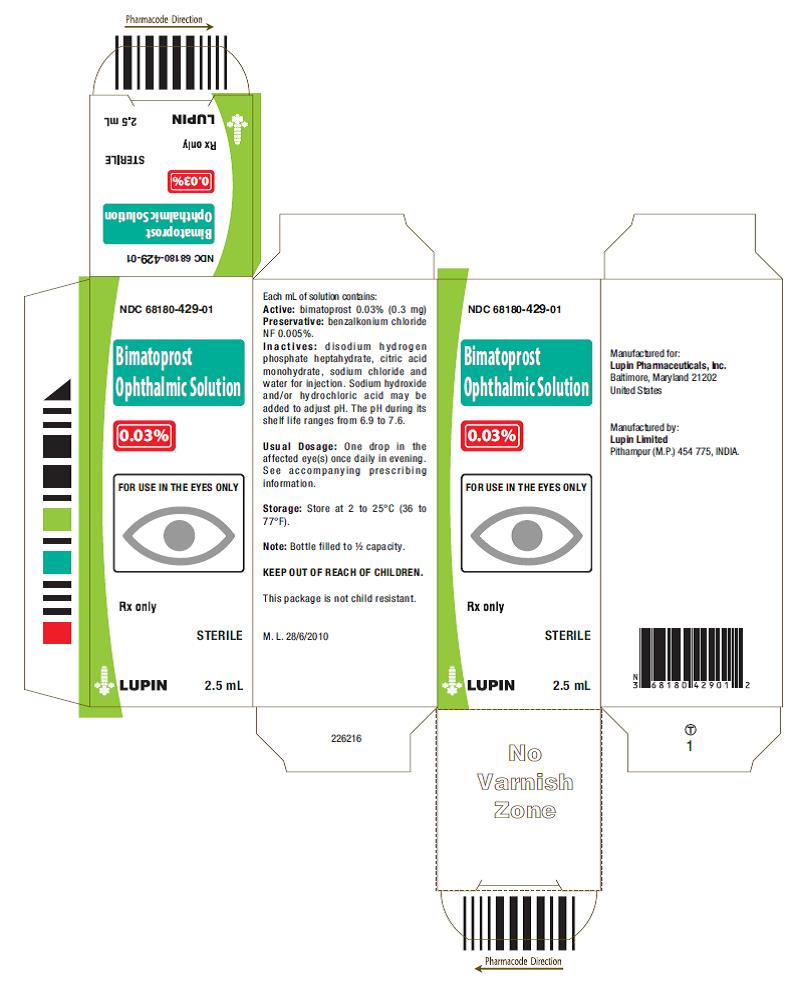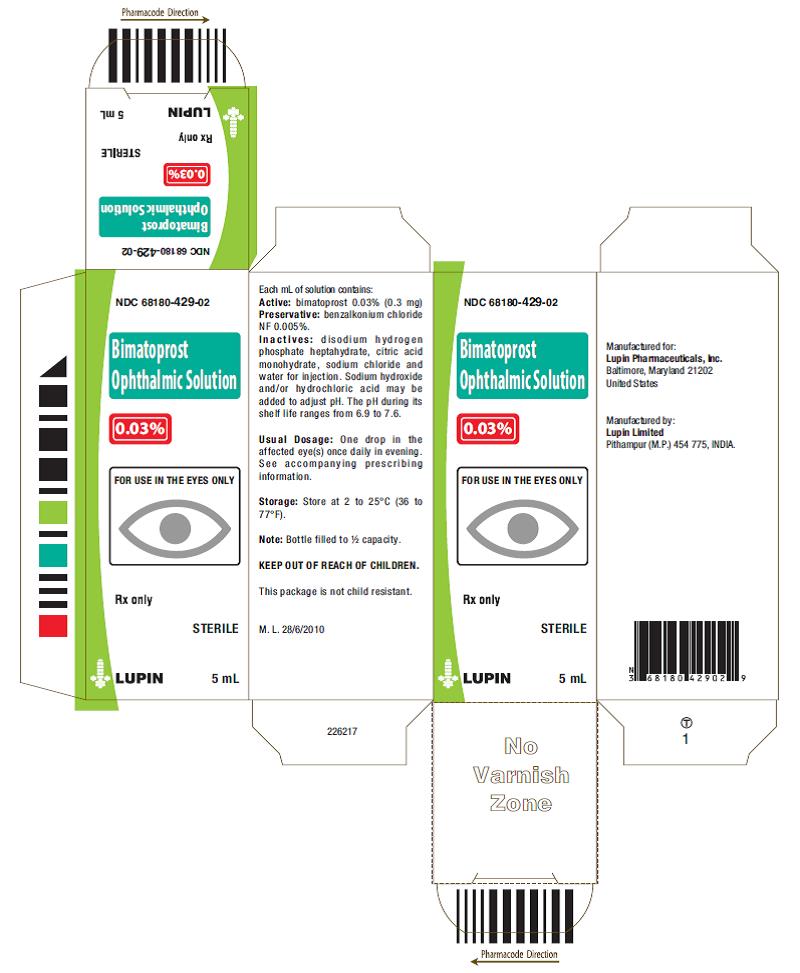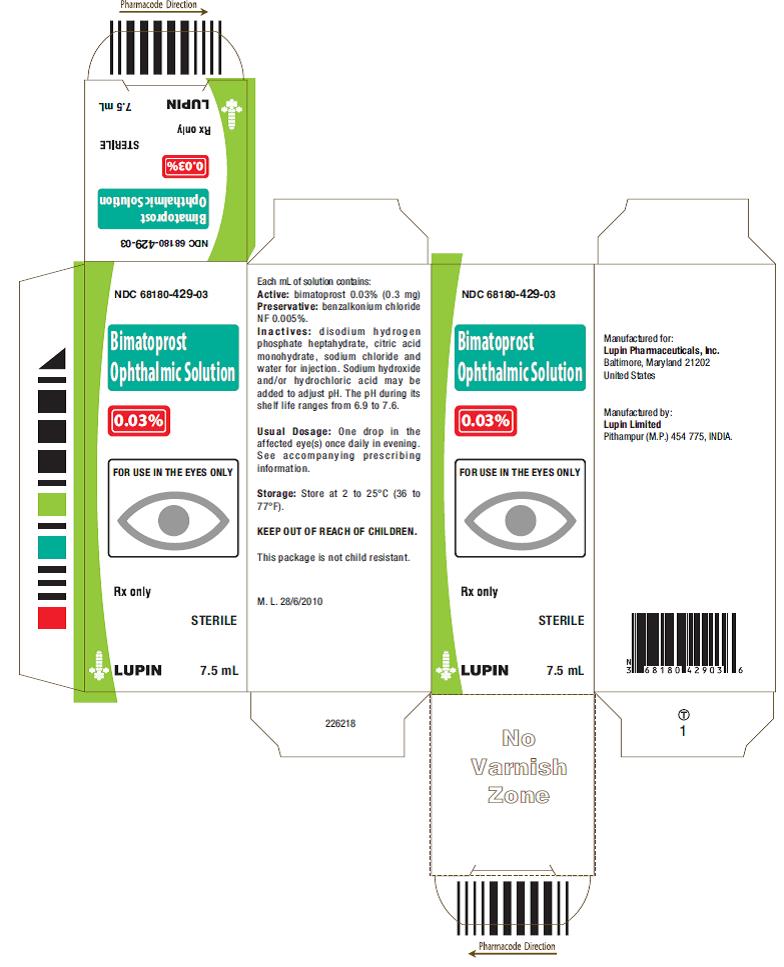Label: BIMATOPROST solution/ drops
-
Contains inactivated NDC Code(s)
NDC Code(s): 57297-429-01, 57297-429-02, 57297-429-03 - Packager: LUPIN LIMITED
- Category: HUMAN PRESCRIPTION DRUG LABEL
- DEA Schedule: None
- Marketing Status: Abbreviated New Drug Application
Drug Label Information
Updated May 4, 2016
If you are a consumer or patient please visit this version.
- Download DRUG LABEL INFO: PDF XML
- Official Label (Printer Friendly)
-
HIGHLIGHTS OF PRESCRIBING INFORMATION
These highlights do not include all the information needed to use Bimatoprost Ophthalmic Solution, 0.03% safely and effectively. See full prescribing information for Bimatoprost Ophthalmic Solution, 0.03%.
BIMATOPROST Ophthalmic Solution, 0.03%
for topical ophthalmic use
Initial U.S. Approval: 2001
RECENT MAJOR CHANGES
Warnings and Precautions, Intraocular Inflammation (5.3) 09/2014
INDICATIONS AND USAGE
Bimatoprost ophthalmic solution, 0.03% is a prostaglandin analog indicated for the reduction of elevated intraocular pressure in patients with open angle glaucoma or ocular hypertension. (1)
DOSAGE AND ADMINISTRATION
One drop in the affected eye(s) once daily in the evening. (2)
DOSAGE FORMS AND STRENGTHS
Solution containing 0.3 mg/mL bimatoprost. (3)
CONTRAINDICATIONS
None. (4)
WARNINGS AND PRECAUTIONS
ADVERSE REACTIONS
Most common adverse reaction is conjunctival hyperemia (45%). (6.1)
To report SUSPECTED ADVERSE REACTIONS, contact Lupin Pharmaceuticals Inc. at 1-800-399-2561 or FDA at 1-800-FDA-1088 or www.fda.gov/medwatch.
USE IN SPECIFIC POPULATIONS
Use in pediatric patients below the age of 16 years is not recommended because of potential safety concerns related to increased pigmentation following long-term chronic use. (8.4)
See 17 for PATIENT COUNSELING INFORMATION.
Revised: 5/2016
-
Table of Contents
FULL PRESCRIBING INFORMATION: CONTENTS*
1 INDICATIONS AND USAGE
2 DOSAGE AND ADMINISTRATION
3 DOSAGE FORMS AND STRENGTHS
4 CONTRAINDICATIONS
5 WARNINGS AND PRECAUTIONS
5.1 Pigmentation
5.2 Eyelash Changes
5.3 Intraocular Inflammation
5.4 Macular Edema
5.5 Bacterial Keratitis
5.6 Use with Contact Lenses
6 ADVERSE REACTIONS
6.1 Clinical Studies Experience
6.2 Postmarketing Experience
8 USE IN SPECIFIC POPULATIONS
8.1 Pregnancy
8.3 Nursing Mothers
8.4 Pediatric Use
8.5 Geriatric Use
8.6 Hepatic Impairment
10 OVERDOSAGE
11 DESCRIPTION
12 CLINICAL PHARMACOLOGY
12.1 Mechanism of Action
12.3 Pharmacokinetics
13 NONCLINICAL TOXICOLOGY
13.1 Carcinogenesis, Mutagenesis, Impairment of Fertility
14 CLINICAL STUDIES
16 HOW SUPPLIED/STORAGE AND HANDLING
17 PATIENT COUNSELING INFORMATION
17.1 Potential for Pigmentation
17.2 Potential for Eyelash Changes
17.3 Handling the Container
17.4 When to Seek Physician Advice
17.5 Use with Contact Lenses
17.6 Use with Other Ophthalmic Drugs
- *
- Sections or subsections omitted from the full prescribing information are not listed.
- 1 INDICATIONS AND USAGE
-
2 DOSAGE AND ADMINISTRATION
The recommended dosage is one drop in the affected eye(s) once daily in the evening.
Bimatoprost ophthalmic solution, 0.03% should not be administered more than once daily since it has been shown that more frequent administration of prostaglandin analogs may decrease the intraocular pressure lowering effect.
Reduction of the intraocular pressure starts approximately 4 hours after the first administration with maximum effect reached within approximately 8 to 12 hours.
Bimatoprost ophthalmic solution, 0.03% may be used concomitantly with other topical ophthalmic drug products to lower intraocular pressure. If more than one topical ophthalmic drug is being used, the drugs should be administered at least five (5) minutes apart.
- 3 DOSAGE FORMS AND STRENGTHS
- 4 CONTRAINDICATIONS
-
5 WARNINGS AND PRECAUTIONS
5.1 Pigmentation
Bimatoprost ophthalmic solution has been reported to cause changes to pigmented tissues. The most frequently reported changes have been increased pigmentation of the iris, periorbital tissue (eyelid) and eyelashes. Pigmentation is expected to increase as long as bimatoprost is administered. The pigmentation change is due to increased melanin content in the melanocytes rather than to an increase in the number of melanocytes. After discontinuation of bimatoprost, pigmentation of the iris is likely to be permanent, while pigmentation of the periorbital tissue and eyelash changes have been reported to be reversible in some patients. Patients who receive treatment should be informed of the possibility of increased pigmentation. The long term effects of increased pigmentation are not known.
Iris color change may not be noticeable for several months to years. Typically, the brown pigmentation around the pupil spreads concentrically towards the periphery of the iris and the entire iris or parts of the iris become more brownish. Neither nevi nor freckles of the iris appear to be affected by treatment. While treatment with bimatoprost ophthalmic solution, 0.03% can be continued in patients who develop noticeably increased iris pigmentation, these patients should be examined regularly [see PATIENT COUNSELING INFORMATION, (17.1)].
5.2 Eyelash Changes
Bimatoprost ophthalmic solution, 0.03% may gradually change eyelashes and vellus hair in the treated eye. These changes include increased length, thickness, and number of lashes. Eyelash changes are usually reversible upon discontinuation of treatment.
5.3 Intraocular Inflammation
Prostaglandin analogs, including bimatoprost, have been reported to cause intraocular inflammation. In addition, because these products may exacerbate inflammation, caution should be used in patients with active intraocular inflammation (e.g., uveitis).
5.4 Macular Edema
Macular edema, including cystoid macular edema, has been reported during treatment with bimatoprost ophthalmic solution. Bimatoprost ophthalmic solution, 0.03% should be used with caution in aphakic patients, in pseudophakic patients with a torn posterior lens capsule, or in patients with known risk factors for macular edema.
5.5 Bacterial Keratitis
There have been reports of bacterial keratitis associated with the use of multiple-dose containers of topical ophthalmic products. These containers had been inadvertently contaminated by patients who, in most cases, had a concurrent corneal disease or a disruption of the ocular epithelial surface [see PATIENT COUNSELING INFORMATION, (17.3)].
-
6 ADVERSE REACTIONS
6.1 Clinical Studies Experience
Because clinical studies are conducted under widely varying conditions, adverse reaction rates observed in the clinical studies of a drug cannot be directly compared to rates in the clinical studies of another drug and may not reflect the rates observed in practice.
In clinical trials, the most frequent events associated with the use of bimatoprost ophthalmic solution, 0.03% occurring in approximately 15% to 45% of patients, in descending order of incidence, included conjunctival hyperemia, growth of eyelashes, and ocular pruritus. Approximately 3% of patients discontinued therapy due to conjunctival hyperemia.
Ocular adverse events occurring in approximately 3 to 10% of patients, in descending order of incidence, included ocular dryness, visual disturbance, ocular burning, foreign body sensation, eye pain, pigmentation of the periocular skin, blepharitis, cataract, superficial punctate keratitis, periorbital erythema, ocular irritation, and eyelash darkening. The following ocular adverse events reported in approximately 1 to 3% of patients, in descending order of incidence, included: eye discharge, tearing, photophobia, allergic conjunctivitis, asthenopia, increases in iris pigmentation, and conjunctival edema. In less than 1% of patients, intraocular inflammation was reported as iritis.
Systemic adverse events reported in approximately 10% of patients were infections (primarily colds and upper respiratory tract infections). The following systemic adverse events reported in approximately 1 to 5% of patients, in descending order of incidence, included headaches, abnormal liver function tests, asthenia and hirsutism.
6.2 Postmarketing Experience
The following reactions have been identified during postmarketing use of bimatoprost ophthalmic solution, 0.03% in clinical practice. Because they are reported voluntarily from a population of unknown size, estimates of frequency cannot be made. The reactions, which have been chosen for inclusion due to either their seriousness, frequency of reporting, possible causal connection to bimatoprost ophthalmic solution, or a combination of these factors, include: abnormal hair growth, dizziness, eyelid edema, hypertension, nausea, and periorbital and lid changes associated with a deepening of the eyelid sulcus.
-
8 USE IN SPECIFIC POPULATIONS
8.1 Pregnancy
Pregnancy Category C
In embryo/fetal developmental studies in pregnant mice and rats, abortion was observed at oral doses of bimatoprost which achieved at least 33 or 97 times, respectively, the maximum intended human exposure based on blood AUC levels.
At doses at least 41 times the maximum intended human exposure based on blood AUC levels, the gestation length was reduced in the dams, the incidence of dead fetuses, late resorptions, peri- and postnatal pup mortality was increased, and pup body weights were reduced.
There are no adequate and well-controlled studies of bimatoprost ophthalmic solution, 0.03% administration in pregnant women. Because animal reproductive studies are not always predictive of human response. Bimatoprost ophthalmic solution, 0.03% should be administered during pregnancy only if the potential benefit justifies the potential risk to the fetus.
8.3 Nursing Mothers
It is not known whether bimatoprost ophthalmic solution, 0.03% is excreted in human milk, although in animal studies, bimatoprost has been shown to be excreted in breast milk. Because many drugs are excreted in human milk, caution should be exercised when bimatoprost ophthalmic solution, 0.03% is administered to a nursing woman.
8.4 Pediatric Use
Use in pediatric patients below the age of 16 years is not recommended because of potential safety concerns related to increased pigmentation following long-term chronic use.
-
10 OVERDOSAGE
No information is available on overdosage in humans. If overdose with bimatoprost ophthalmic solution, 0.03% occurs, treatment should be symptomatic.
In oral (by gavage) mouse and rat studies, doses up to 100 mg/kg/day did not produce any toxicity. This dose expressed as mg/m2 is at least 70 times higher than the accidental dose of one bottle of bimatoprost ophthalmic solution, 0.03% for a 10 kg child.
-
11 DESCRIPTION
Bimatoprost ophthalmic solution, 0.03% is a synthetic prostamide analog with ocular hypotensive activity. Its chemical name is (Z)-7-[(1R,2R,3R,5S)-3,5-Dihydroxy-2-[(1E,3S)-3-hydroxy-5-phenyl-1-pentenyl]cyclopentyl]-5-N-ethylheptenamide, and its molecular weight is 415.58. Its molecular formula is C25H37NO4. Its chemical structure is:

Bimatoprost is a powder, which is freely soluble in alcohol. Bimatoprost ophthalmic solution, 0.03% is a clear, isotonic, colorless, sterile ophthalmic solution with an osmolality of approximately 290 mOsmol/kg.
Bimatoprost ophthalmic solution, 0.03% contains Active: bimatoprost 0.3 mg/mL; Inactives: benzalkonium chloride 0.05 mg/mL; disodium hydrogen phosphate heptahydrate, citric acid monohydrate, sodium chloride and water for injection. Sodium hydroxide and/or hydrochloric acid may be added to adjust pH. The pH during its shelf life ranges from 6.9 to 7.6.
-
12 CLINICAL PHARMACOLOGY
12.1 Mechanism of Action
Bimatoprost, a prostaglandin analog, is a synthetic structural analog of prostaglandin with ocular hypotensive activity. It selectively mimics the effects of naturally occurring substances, prostamides. Bimatoprost is believed to lower intraocular pressure (IOP) in humans by increasing outflow of aqueous humor through both the trabecular meshwork and uveoscleral routes. Elevated IOP presents a major risk factor for glaucomatous field loss. The higher the level of IOP, the greater the likelihood of optic nerve damage and visual field loss.
12.3 Pharmacokinetics
Absorption
After one drop of bimatoprost ophthalmic solution, 0.03% was administered once daily to both eyes of 15 healthy subjects for two weeks, blood concentrations peaked within 10 minutes after dosing and were below the lower limit of detection (0.025 ng/mL) in most subjects within 1.5 hours after dosing. Mean Cmax and AUC0-24hr values were similar on days 7 and 14 at approximately 0.08 ng/mL and 0.09 ng•hr/mL, respectively, indicating that steady state was reached during the first week of ocular dosing. There was no significant systemic drug accumulation over time.
Distribution
Bimatoprost is moderately distributed into body tissues with a steady-state volume of distribution of 0.67 L/kg. In human blood, bimatoprost resides mainly in the plasma. Approximately 12% of bimatoprost remains unbound in human plasma.
Metabolism
Bimatoprost is the major circulating species in the blood once it reaches the systemic circulation following ocular dosing. Bimatoprost then undergoes oxidation, N-deethylation and glucuronidation to form a diverse variety of metabolites.
Elimination
Following an intravenous dose of radiolabeled bimatoprost (3.12 mcg/kg) to six healthy subjects, the maximum blood concentration of unchanged drug was 12.2 ng/mL and decreased rapidly with an elimination half-life of approximately 45 minutes. The total blood clearance of bimatoprost was 1.5 L/hr/kg. Up to 67% of the administered dose was excreted in the urine while 25% of the dose was recovered in the feces.
-
13 NONCLINICAL TOXICOLOGY
13.1 Carcinogenesis, Mutagenesis, Impairment of Fertility
Bimatoprost was not carcinogenic in either mice or rats when administered by oral gavage at doses of up to 2 mg/kg/day and 1 mg/kg/day respectively (at least 192 and 291 times the recommended human exposure based on blood AUC levels respectively) for 104 weeks.
Bimatoprost was not mutagenic or clastogenic in the Ames test, in the mouse lymphoma test, or in the in vivo mouse micronucleus tests.
Bimatoprost did not impair fertility in male or female rats up to doses of 0.6 mg/kg/day (at least 103 times the recommended human exposure based on blood AUC levels).
- 14 CLINICAL STUDIES
-
16 HOW SUPPLIED/STORAGE AND HANDLING
Bimatoprost ophthalmic solution, 0.03% is supplied sterile in opaque white low density polyethylene bottle which is closed with white low density polyethylene nozzle and then with turquoise colored high density polyethylene cap in the following sizes:
2.5 mL fill in a 5 mL container - NDC 68180-429-01
5 mL fill in a 10 mL container - NDC 68180-429-02
7.5 mL fill in a 10 mL container - NDC 68180-429-03
Storage: Bimatoprost ophthalmic solution, 0.03% should be stored at 2 to 25°C (36 to 77°F).
-
17 PATIENT COUNSELING INFORMATION
17.1 Potential for Pigmentation
Advise patients about the potential for increased brown pigmentation of the iris, which may be permanent. Also inform patients about the possibility of eyelid skin darkening, which may be reversible after discontinuation of bimatoprost ophthalmic solution, 0.03%.
17.2 Potential for Eyelash Changes
Inform patients of the possibility of eyelash and vellus hair changes in the treated eye during treatment with bimatoprost ophthalmic solution, 0.03%. These changes may result in a disparity between eyes in length, thickness, pigmentation, number of eyelashes or vellus hairs, and/or direction of eyelash growth. Eyelash changes are usually reversible upon discontinuation of treatment.
17.3 Handling the Container
Instruct patients to avoid allowing the tip of the dispensing container to contact the eye, surrounding structures, fingers, or any other surface in order to avoid contamination of the solution by common bacteria known to cause ocular infections. Serious damage to the eye and subsequent loss of vision may result from using contaminated solutions.
17.4 When to Seek Physician Advice
Advise patients that if they develop an intercurrent ocular condition (e.g., trauma or infection), have ocular surgery, or develop any ocular reactions, particularly conjunctivitis and eyelid reactions, they should immediately seek their physician's advice concerning the continued use of bimatoprost ophthalmic solution, 0.03%.
17.5 Use with Contact Lenses
Advise patients that bimatoprost ophthalmic solution, 0.03% contains benzalkonium chloride, which may be absorbed by soft contact lenses. Contact lenses should be removed prior to instillation of bimatoprost ophthalmic solution, 0.03% and may be reinserted 15 minutes following its administration.
-
PACKAGE LABEL.PRINCIPAL DISPLAY PANEL
BIMATOPROST OPHTHALMIC SOLUTION
Rx Only
0.03%
NDC 68180-429-01
2.5 mL Bottle Label
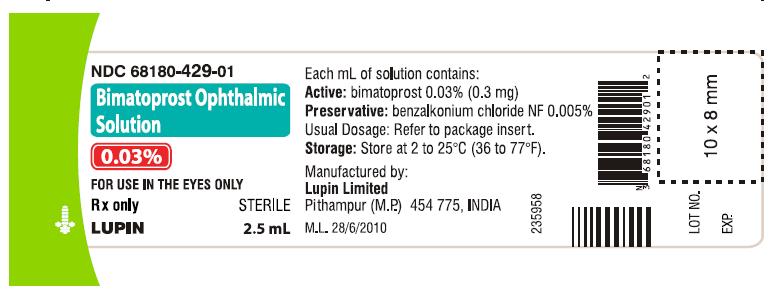
BIMATOPROST OPHTHALMIC SOLUTION
Rx Only
0.03%
NDC 68180-429-01
2.5 mL Carton Label

BIMATOPROST OPHTHALMIC SOLUTION
Rx Only
0.03%
NDC 68180-429-02
5 mL Bottle Label
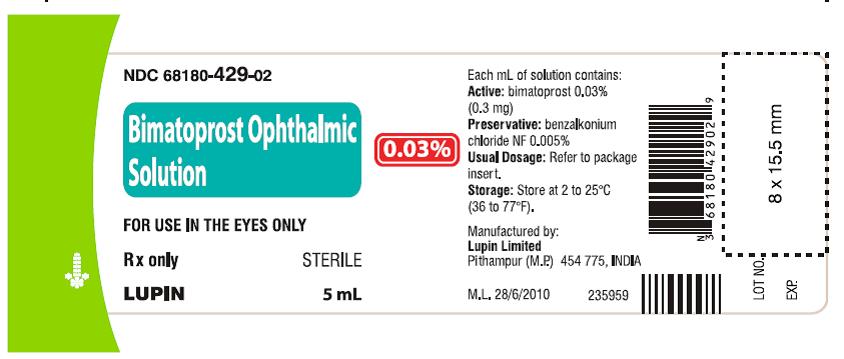
BIMATOPROST OPHTHALMIC SOLUTION
Rx Only
0.03%
NDC 68180-429-02
5 mL Carton Label
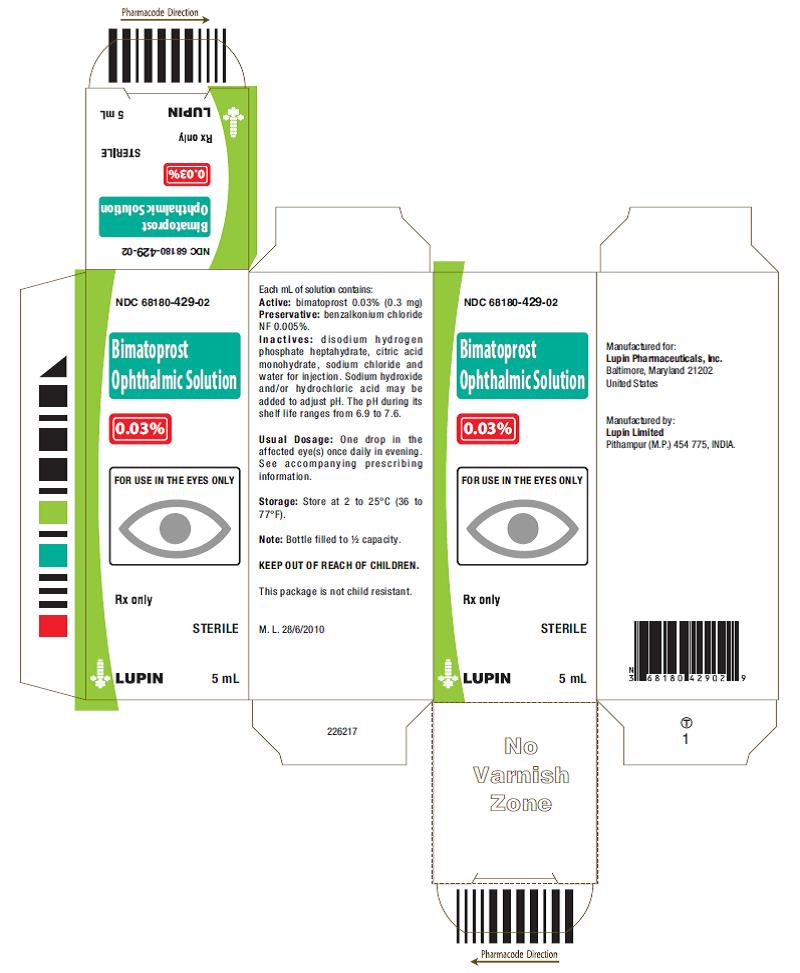
BIMATOPROST OPHTHALMIC SOLUTION
Rx Only
0.03%
NDC 68180-429-03
7.5 mL Bottle Label
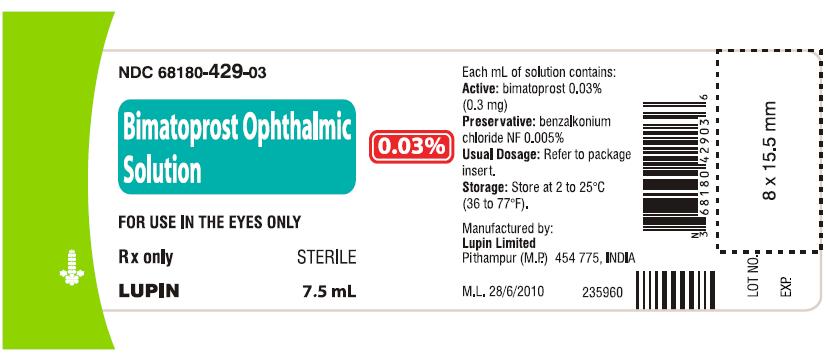
BIMATOPROST OPHTHALMIC SOLUTION
Rx Only
0.03%
NDC 68180-429-03
7.5 mL Carton Label

-
INGREDIENTS AND APPEARANCE
BIMATOPROST
bimatoprost solution/ dropsProduct Information Product Type HUMAN PRESCRIPTION DRUG Item Code (Source) NDC:57297-429 Route of Administration OPHTHALMIC Active Ingredient/Active Moiety Ingredient Name Basis of Strength Strength BIMATOPROST (UNII: QXS94885MZ) (BIMATOPROST - UNII:QXS94885MZ) BIMATOPROST 0.3 mg in 1 mL Inactive Ingredients Ingredient Name Strength BENZALKONIUM CHLORIDE (UNII: F5UM2KM3W7) CITRIC ACID MONOHYDRATE (UNII: 2968PHW8QP) HYDROCHLORIC ACID (UNII: QTT17582CB) SODIUM CHLORIDE (UNII: 451W47IQ8X) SODIUM HYDROXIDE (UNII: 55X04QC32I) SODIUM PHOSPHATE, DIBASIC, HEPTAHYDRATE (UNII: 70WT22SF4B) WATER (UNII: 059QF0KO0R) Packaging # Item Code Package Description Marketing Start Date Marketing End Date 1 NDC:57297-429-02 1 in 1 CARTON 05/13/2015 1 5 mL in 1 BOTTLE, DROPPER; Type 0: Not a Combination Product 2 NDC:57297-429-03 1 in 1 CARTON 05/13/2015 2 7.5 mL in 1 BOTTLE, DROPPER; Type 0: Not a Combination Product 3 NDC:57297-429-01 1 in 1 CARTON 05/13/2015 3 2.5 mL in 1 BOTTLE, DROPPER; Type 0: Not a Combination Product Marketing Information Marketing Category Application Number or Monograph Citation Marketing Start Date Marketing End Date ANDA ANDA203991 05/13/2015 Labeler - LUPIN LIMITED (675923163) Registrant - LUPIN LIMITED (675923163) Establishment Name Address ID/FEI Business Operations LUPIN LIMITED 863645527 manufacture(57297-429) , pack(57297-429)


